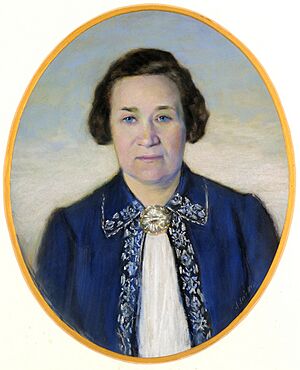Linda Eenpalu facts for kids
Linda Marie Eenpalu (born Linda Marie Koplus) was an important Estonian politician and a strong supporter of women's rights. She was born on September 20, 1890, and passed away on June 4, 1967.
Linda Eenpalu made history as the first woman to be part of the National Constituent Assembly in 1937. She was also the first woman in the Second Chamber of the National Council in 1938. She worked hard to improve the lives of women in Estonia. Linda was married to Kaarel Eenpalu, who was the prime minister of Estonia from 1938 to 1939.
Contents
Linda Eenpalu's Early Life and Education
Linda Eenpalu started her studies in Tartu, Estonia, between 1911 and 1912. She believed in the power of education and learning. Her early life helped her prepare for a future where she would make a big difference.
Her Work as a Librarian and Teacher
Linda Eenpalu worked as a librarian at the Tartu Public Library Society from 1913 to 1914. Later, she was a librarian at a high school for girls between 1919 and 1920. She also taught at a high school in Stockholm from 1920 to 1926. These roles showed her dedication to helping others learn and grow.
A Champion for Women's Rights
Linda Eenpalu was a true pioneer for women in Estonia. She helped start the Estonian Female Student's Society in 1911. This group supported young women who were studying. She later became a key member of the Estonian Women's Club in 1928.
Leading Rural Women
From 1929 to 1940, Linda Eenpalu was the Chairperson of the Central Society of the Estonian Rural Women. In this role, she worked to empower women living in the countryside. She helped them have a stronger voice and better opportunities.
Her Role in Estonian Politics
Linda Eenpalu was a member of the National Economic Council from 1935 to 1938. This council helped guide Estonia's economy. In 1937, she joined the national housing department, working on important issues related to homes and living conditions.
Her most significant political role was in the Second Chamber of the National Council. From 1938 to 1940, she was the only woman in this important group. This showed her strength and determination to represent women in government.
Challenges During Wartime
In 1941, Linda Eenpalu faced a very difficult time. She was arrested and sent to a distant part of Russia, in Tomsk Oblast. She had to live there until 1956. Despite these challenges, she remained a symbol of strength and resilience.


